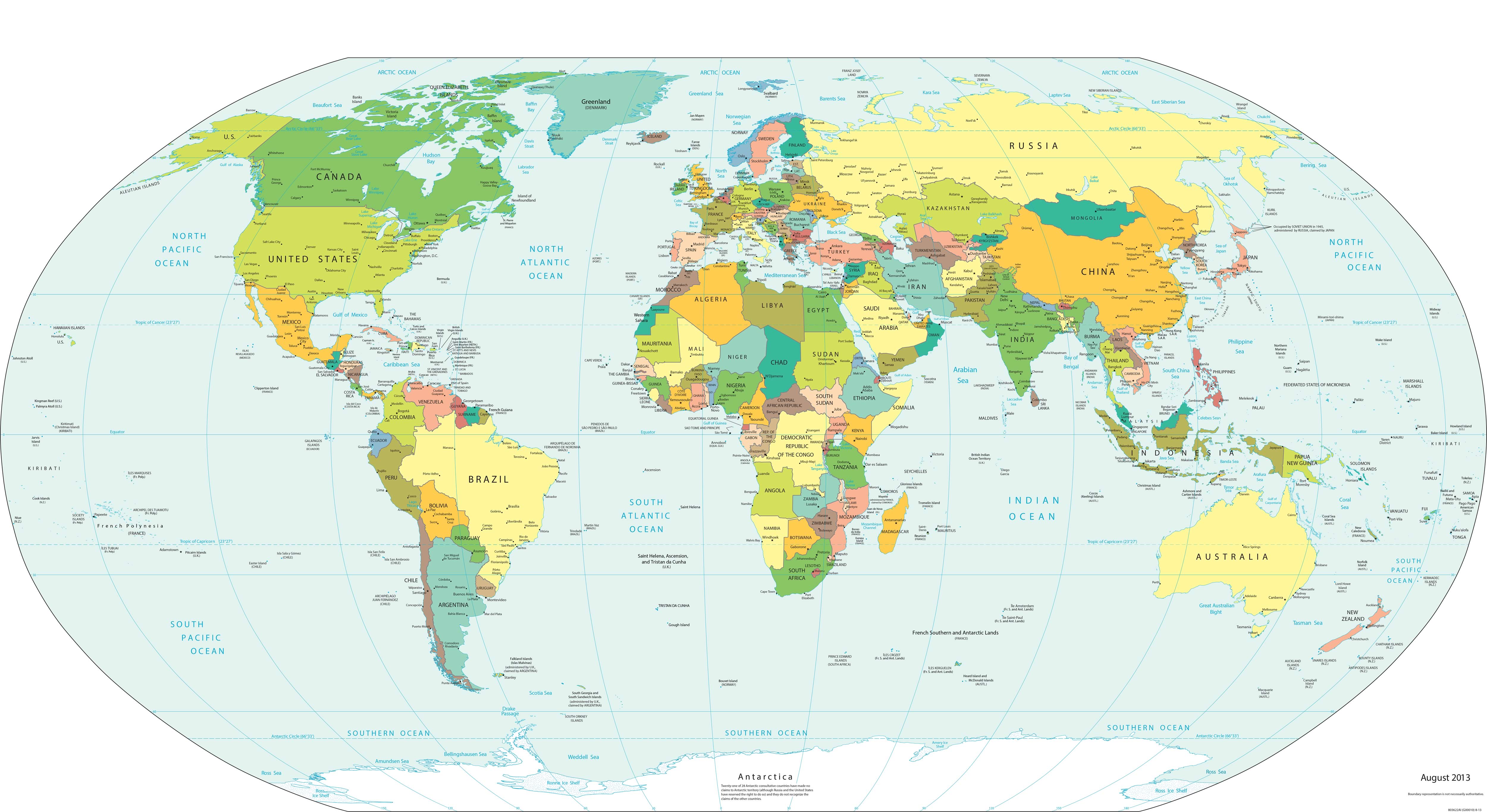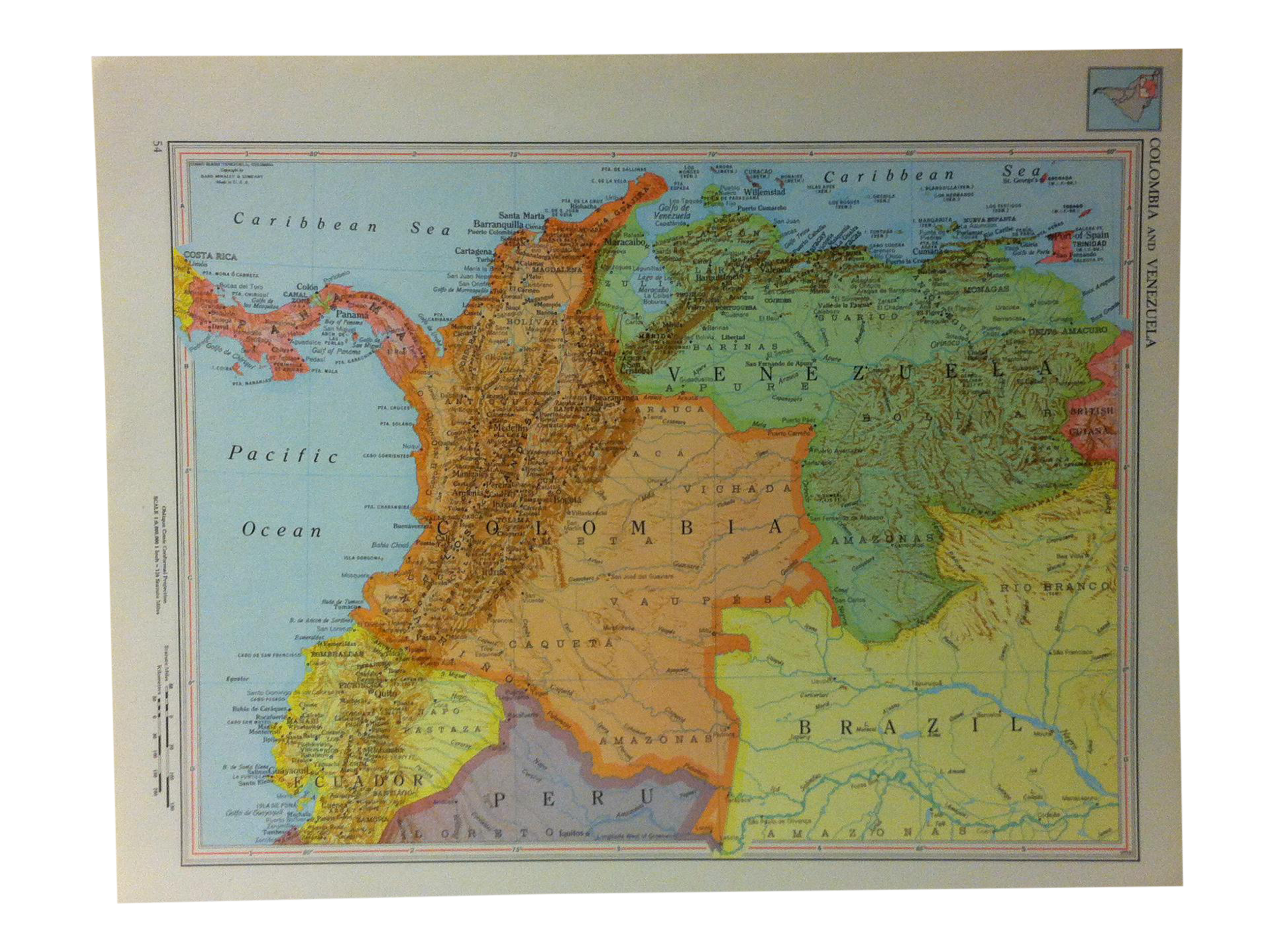World Map With Venezuela - Although every effort has been made to adhere to the rules of the quotation process, changes may occur. If you have questions, consult the appropriate style manual or other resources.
Venezuela is a country in the northern part of South America. It occupies a triangular area larger than France and Germany combined. Venezuela is bordered to the north by the Caribbean Sea and the Atlantic Ocean, to the east by Guyana, to the south by Brazil, and to the southwest by Colombia. The capital of the country, Caracas, is Venezuela's main center of industry, commerce, education, and tourism.
World Map With Venezuela
Venezuela controls many islands and islets of the Caribbean, including Margarita Island, La Blanquilla, La Tortuga, Los Roques and Los Monjes. Since the early 19th century, Venezuela has controlled a total of about 53,000 square miles (137,000 km2) of Guyana's territory west of the Essequibo River—almost two-thirds of Guyana's land area. . Venezuela and Colombia have long been in dispute over the maritime boundaries in the Gulf of Venezuela and the Los Monjes archipelago.
Venezuela: General Information
A physiologically different country, Venezuela includes the northern part of the mountains and highlands in the Andes, large parts of the Orinoco River Basin and its wide Llanos (land), Lake Maracaibo, the largest lake in the Americas South, with the spectacular Angel Falls. the highest waterfall in the world. The pattern of government development is unique in Latin American countries in terms of speed, sequence and timing of economic and population growth. In the 20th century, Venezuela changed from a poor agricultural society to a rapidly urbanizing society, made possible by the use of large oil reserves. However, these changes have come with an imbalance between the country's regions and economic sectors, and Venezuela's cities are swelling due to more and more uncontrolled immigration. from rural areas and large amounts of illegal immigration from Colombia and other neighboring countries.
Venezuela, like many other Latin American countries, has high levels of urban poverty, high external debt, and widespread government support and corruption. Venezuela's social and political crisis has been compounded by natural disasters such as the floods that devastated Caracas, La Guaira and other coastal areas at the end of 1999. On the other hand, from 1958 to the beginning of the 21st century, the government became more democratic. It is more politically stable than most Latin American countries, and its economy has benefited from a booming oil industry that has sold many of its oil products. resources in the world. The position of Venezuela in the world became more uncertain in the second decade of the 21st century due to the conflict of the power of the revolutionary leader Hugo Chávez, the great decline in the economy of oil production, and the growing power of Chávez's successor, Nicholás Maduro. .
The landscape of Venezuela consists of high mountains, tropical forests, river plains, and coastal plains, all of which offer many natural habitats and many challenges for social interaction and development. the economy.
The topography of Venezuela can be divided into three elevations: the plains, up to about 1,650 feet (500 meters) above sea level, the mountains, up to 16,400 feet (5,000 meters), and in high mountain forests. , where E peaks are scattered above 6,550 feet (2,000 meters). Within these broad divisions, seven physiographic regions can be distinguished: the islands and plains, including the Orinoco delta; the Lake Maracaibo lowlands; Merida and Perija are mountains of the Andes; the coastal mountain range (with its coastal and interior); the northwest valleys and mountains, also known as the highlands of Segovia; the Llanos; and Guiana Highlands.
Maduro Vs. Guaidó: A Global Scorecard
The islands and plains are located in the north. These include the Caribbean "leeward islands" such as Margarita and La Tortuga, as well as several peninsulas, including the headland Paraguaná in the northwest and Araya and Paria in the northeast, the end of a land finger towards Trinidad. . The coastal plains extend east from the border of Colombia and the Gulf of Venezuela to the foothills of the coast, interrupted to the east by the Unare River. Further east is the Orinoco Delta, which opens to the Atlantic Ocean through several branches (
); a quick gateway into the countryside, a low-lying, wet, swampy area that's heavily criss-crossed by rivers.
The two branches of the Andes flow to the northwest of Venezuela, including the highest mountains of the country, the extension to the northeast of the Cordillera Oriental of the Colombian Andes. The western branch, the Perijá Mountains (Sierra de Perijá or Serranía de los Motilones), runs along the Colombian border, while the eastern branch, the Cordillera de Mérida, runs from the border to the state of Lara and divides Lake Maracaibo. from the Orinoco river. From a physical point of view, the highlands of Segovia and the northwest coast of Barquisimeto can also be part of the Andes chain. The highest point in the Venezuelan Andes is Bolívar Peak (La Columna), reaching 16,332 feet (4,978 meters) in the Cordillera de Mérida. Between the high mountains of the Andes lies Lake Maracaibo and its lowlands; this reservoir is one of the main oil producing areas in the country.

The coastal mountains, almost two parallel lines - the Coast and the Internet - have the largest population of Venezuela, although they cover only a small part of the country's territory . The intermontane valleys contain the major cities of Caracas, Valencia, and Maracay, and all but the highest mountains are inhabited. At 9,072 feet (2,765 meters), Naiguatá Peak is the highest point on the coast.
Venezuela Map Royalty Free Vector Image
The northwestern valleys and mountains lie east of Lake Maracaibo and form part of a rift zone between the coast and the Andean mountains. The elevation ranges from 1,600 to 5,500 feet (490 to 1,680 meters). This area is the only desert in Venezuela - the sand dunes that surround the city of Coro.
Along the Orinoco River lies the Llanos, a flat area of savannah and tropical forest, where the land is divided only between low plateaus, such as mesa and shallow, flat, humid river course. Cattle ranches and oil exploration dominate this densely populated area, which experiences floods in the summer and drought in the winter. From the foothills of the Andes to the Orinoco Delta, the Llanos extend for about 800 miles (1,300 km), with a width ranging from 100 miles (160 km) east to more than 300 miles (500 km) west.
Extending from the Orinoco in the south (Amazonas) bordering Colombia, Brazil, and Guyana is the large Guiana Highlands, or Guayana, a mountain of ancient glass rocks mostly on rounded hills and narrow valley Occupying more than two-fifths of the country's territory, it is the most remote and least explored part of Venezuela. On the southern border of Brazil, areas of large plains and steep sides, are called.
To the southeast of Camón, Chimanta and the famous mountain of Roraima, which is 2,772 meters high on the border of Guyana. Like the lowlands of the Llanos, the
Abstract Blue World Map Magnified Venezuela Stock Vector (royalty Free) 437697658
Angel Falls (Parecupá Merú), the highest waterfall in the world, is 979 meters from the Auyán Rocks in a region called La Gran Sabana in the southeastern Guiana Highlands.
(Auyantepui) on the floor of the valley below. Other important waterfalls in the region: Torón, Karuay and Jurij. The high mountains are sparsely populated but rich in wealth; they are rich in iron, gold and diamond deposits and have a lot of hydropower as well as strong forest resources. Venezuela's military in the mountains has long been concerned about a territorial dispute with Guyana and the illegal crossing of people, cattle and drugs along the Colombian-Brazilian border. The total area is 916,445 square meters. km (353,841 sq mi), Venezuela, located in the north of South America, is the 33rd largest country in the world. As you can see on the physical map of Venezuela, the Orinoco River and the mountains of Venezuela divide the country into several distinct regions, each with a different climate.
The lowlands of Maracaibo in the north-west are dry, windless and hot; the Andes and the northern highlands are more favorable and cooler at higher altitudes; the central plain in front of the Orinoco River covers about a third of the country, most of which is less than 50 meters above sea level, and is generally warm. It covers the southeast, the wild and largely unexplored Guyana Highlands of rainforests-tropical, hot and humid, with heights up to 3,500 meters.

The highest point of the country - the 4,979 m (16,335 ft) Pico Bolivar [marked as a yellow triangle on the map] lies in the mountains to the north.
Venezuela Political Wall Map
The highest waterfall in the world - Angel Falls in the Andes Mountains located in the Guyana Highlands; At 2,421 feet (751 m), it is more than 12 times the height of Niagara Falls in the US and Canada. above 10,

Post A Comment:
0 comments so far,add yours